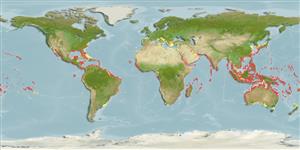Common names from other countries
Classification / Names / Names
Populaire namen | Synoniemen | Catalog of Fishes (gen., sp.) | ITIS | CoL | WoRMS
Environment: milieu / climate zone / depth range / distribution range
Ecologie
; diepteverspreiding 0 - 30 m (Ref. 80758). Tropical
Atlantic and Indo-Pacific oceans and the Mediterranean Sea.
Length at first maturity / Size / Gewicht / Leeftijd
Maturity: Lm ? range ? - ? cm
Characterized by the usually unbranched, narrow, feather-like erect branches. The pinnately arranged pinnules (ramuli) are distinctly flattened and sickle-shaped. Erect branches up to 5 cm in height (Ref. 80758).
Used as food and medicine: antifungal, to lower blood pressure (Ref. 80758). Inhabits soft to hard, sandy or rocky substrate in calm to moderately exposed habitats. Abundant in quiet waters or in tide pools. Plants of sheltered shores and in shallow water grow on sand, mud, or rocks; sometimes found in moderately exposed situations and dredged to a depth of 30 m on sand and gravel (Ref. 80758).
Guiry, M.D. and G.M. Guiry. 2009. (Ref. 80701)
Status op de Rode Lijst van het IUCN (Ref. 130435)
Status bij CITES (Ref. 108899)
Not Evaluated
Not Evaluated
Gevaarlijk voor mensen
Gebruik door de mens
Visserij: commercieel
| FishSource |
Tools
Meer informatie
Leeftijd/GrootteGroeiLengte-gewicht parametersLengte-lengte parametersMorfologieLarvenAbundantie
Internet-bronnen
Estimates based on models
Preferred temperature
(Ref.
115969): 23.3 - 29.2, mean 27.8 (based on 5331 cells).
